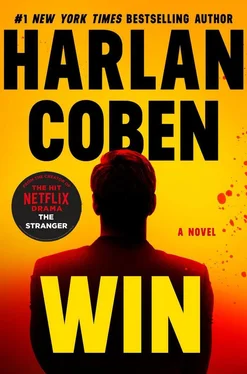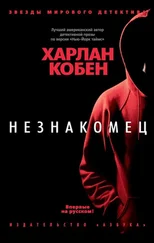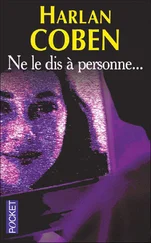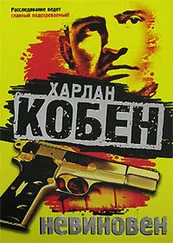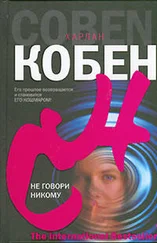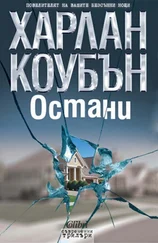I turn to him. “Try me.”
“Arlo didn’t want to kill that agent.”
“Well, yes, I’m sure that’s true.”
“But that agent,” he continues. “He shot first.”
A cold trickle slithers down my back. I want to ask for him to elaborate, but I don’t want to lead him either. So I wait.
“Special Agent O’Malley came in through the back door. Alone. Without a partner. Without backup. He didn’t give Arlo a chance to surrender. He just fired.” He tilts his head. “Have you ever seen old photographs of Arlo?”
I nod numbly.
“He had that huge Afro back then. The bullet, Arlo told me, traveled right through it. Literally parted his hair. Then — and only then — did Arlo fire back.”
Two conversations echo and then ricochet through my head.
First, Leo Staunch’s words about his uncle came back to me:
“He made it very clear that anyone who gave us information on any of the Jane Street Six — or heck, could prove he killed one — would be richly rewarded.”
Second, my conversation with PT when this all began:
“We only sent two agents to the brownstone.”
“No backup?”
“No.”
“Should have waited.”
Why hadn’t they waited for backup?
The answer seems fairly clear now.
Without another word, I turn and start back down the path.
I know it all now. Leo Staunch had hinted as much to me. He told me when I found Arlo Sugarman, I would find all my answers. He was right, I realize. In terms of the Jane Street Six, there is still a bit of cleanup work to do, but I came here for answers and now I have them.
Calvin Sinclair calls after me. “Win?”
I don’t stop.
“Are you going to tell?” he calls out.
But I still don’t stop.
Back on the jet, I get three calls.
The first I see incoming is from PT. I don’t want to talk to him quite yet, not when I’m so close to the end game, and so I let it go into the voicemail. This will no doubt displease PT, who will quickly deduce that I am avoiding him, but I can live with that.
The second call is from Kabir.
“Articulate,” I say, opening up the browser on my laptop. Kabir will normally email me all relevant backing documentation because, again, like my daughter, I am visual.
But his reply catches me off guard: “I have Pierre-Emmanuel Claux on the line. He sounds upset.”
It takes me a second to remember the name of the art curator and restorer whom I had insisted the FBI use to authenticate and tenderly care for the family’s Vermeer. I tell Kabir to patch the call through.
“Mr. Lockwood?”
“Speaking?”
“This is Pierre-Emmanuel Claux at the Institute of Fine Arts at NYU.” I hear the muffled panic in his tone. “You asked me to look into a painting the FBI recently located for authentication and condition purposes — The Girl at the Piano by Johannes Vermeer.”
“Yes, of course.”
“When can you get to the institute, Mr. Lockwood?”
“Is this urgent?”
“It is, yes.”
“Is there an issue with the Vermeer?”
“I think it’s better if we discuss this in person.” I hear the quake in his voice. “As soon as possible, please.”
I check the time. Depending on traffic, it should take about three hours in total.
“Will you still be there?” I ask him.
“The institute will be closed, but I won’t leave until you arrive.”
The third call is from Ema.
After I offer up my customary greeting, Ema asks, “Any updates?”
I fill her in on the day’s happenings. I don’t hold back. I don’t sugarcoat. I do feel my heart swell, but alas, so what? As Ema might say, “Get over it.” I finish by telling her I’m heading straight to New York University Institute of Fine Arts’ Conservation Center across Central Park from the Dakota.
“Oh good,” Ema says. “That’s why I called.”
“Go on.”
“I’m going over the FBI witness transcripts for the art heist at Haverford,” she continues.
“And?”
“And the early investigators seemed convinced that it was an inside job, most notably the night guard, Ian Cornwell. In the end, they had no proof so they dropped it.”
I tell her I know all this.
Ema says, “You questioned Cornwell, right?”
“I did. He’s a political science professor at Haverford now.”
“Yeah, I saw that. What did you think of him?”
I do not want to prejudice her reaction. “What do you think of him?”
“I think the original investigators got it right. There is just no way it could have worked the way Ian Cornwell claims.”
“Yet,” I say, “those investigators couldn’t make the case.”
“Doesn’t mean he didn’t do it.”
“Doesn’t mean that at all,” I agree. I hear street noise. “Where are you?”
“I’m heading into the subway, so I can catch the train home.”
“I’ll have someone drive you.”
“I’d rather do it this way, Win. Anyway, I don’t know how, but we need to get Ian Cornwell to talk. He’s the key. Oh, and let me know what the art conservator tells you.”
Ema hangs up. I replay the conversation in my head, and I know that as I do, I have a smile on my face. I close my eyes and try to nap for the duration of the flight. That won’t happen. I am feeling itchy, antsy, and I know why. I take out my phone and find my favorite app. I set up a rendezvous for tonight at midnight with username “Helena.” Midnight is later than I normally do, but it seems today will be a hectic day.
NYU’s Institute of Fine Arts is located on Fifth Avenue in the French-styled James B. Duke House, one of the few surviving “millionaire mansions” from New York’s Gilded Age. James Duke — yes, my beloved alma mater, Duke University, is named for his father — made his fortune as a founding partner in the American Tobacco Company, modernizing the manufacturing and marketing of cigarettes. The old adage is that behind every great fortune there is a great crime — or, as in this case, if not a great crime, the fortune was certainly built on a pile of dead bodies.
The institute has a boatload of security for obvious reasons. I pass through it all and find Pierre-Emmanuel Claux pacing alone in the second-floor conservatory. He wears a white lab coat and latex gloves. When he turns toward me, I can see something akin to terror on his face.
“Thank God you’re here.”
The conservatory is a hybrid of the old-school mansion and a state-of-the-art research center. There are long tables and special lighting and tapestries and paintbrushes and scalpels and what look like microscopes and dental tools and medical testing equipment.
“I’m sorry for the dramatics, but I think...”
His voice fades out. I don’t see the Vermeer, that image of the girl at the piano. The longest table holds but one item, a possible painting facedown, and it is approximately the correct size of the Vermeer. Next to it sits a Phillips-head screwdriver and several screws.
Pierre-Emmanuel walks toward it. I follow.
“First of all,” he says, his tone steadier now, “the painting is authentic. This is indeed The Girl at the Piano by Vermeer, most likely painted in 1656.” There is a hushed awe in his voice. “I can’t tell you what an honor it is to be in its presence.”
I give him this moment of silence, as though this is a religious service, which, for him, may be apropos. When I meet his eyes, Pierre-Emmanuel clears his throat. “Let me get to why I so urgently needed to see you.” He points to the back of the painting. “First off, there was a Masonite backing board covering the entire reverse of your Vermeer. It’s not original obviously, but Masonite backings are not uncommon. They protect the painting from dust and physical impact.”
Читать дальше
